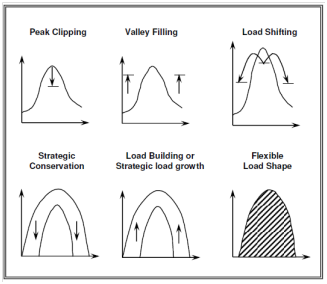Peak Clipping means the reduction of the system peak loads at exact periods.
It embodies one of the typical forms of load management. Peak clipping is commonly considered to be decreasing peak loads by the utility's direct control on equipment used through the consumer or through tariff clauses whereby a consumer curtails his/her load at certain hours of the day. This procedure not only offers the possibility of reducing the required for installing additional power plants, but it also allows to decreased the operational costs of power stations and, to a certain extent, the dependence on fossil fuels (such as natural gas, heating oil) for generating electricity.

Figure: Effects of DSM on Load Shape
Energy management control systems (EMCSs) could be used to switch electrical equipment on or off for load levelling reasons. Some EMCSs enable direct off-site control (through the electric supply company) of user equipment. These are direct load control switches which permit the electric company to control appliances such as air conditioners during periods of maximum demand. Classically applied to heating, ventilation, cooling, and lighting loads, EMCSs could also be used to invoke on-site generators, thereby decreasing peak demand for grid electricity.